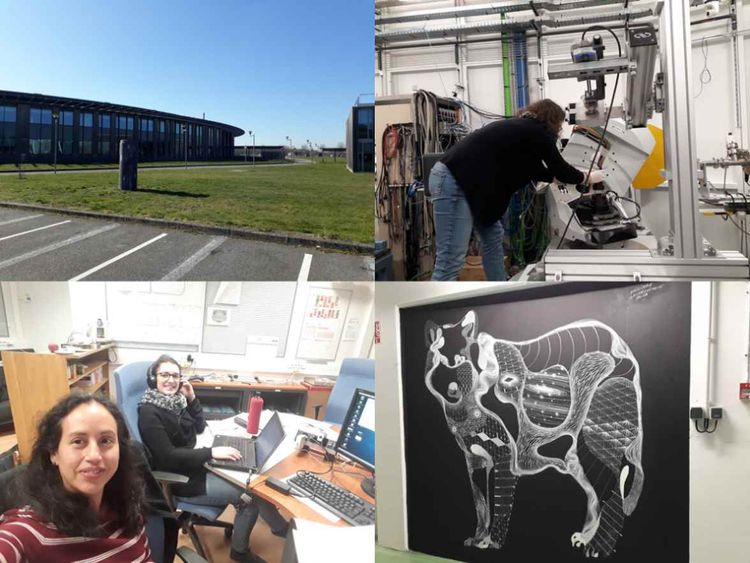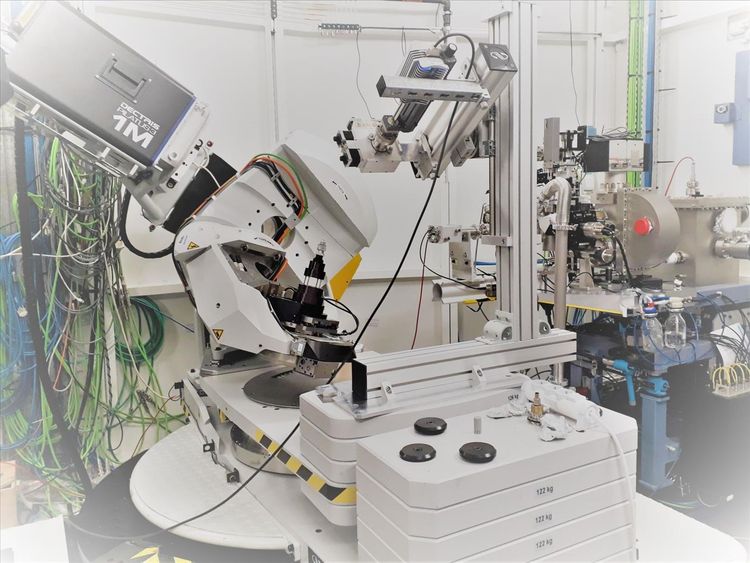In order to do experiments that cannot be done in a conventional laboratory, experimental physicist go on beamtime, this means a research stay, at a large-scale facility like CERN or a synchrotron light source. The way to get such a beamtime is tedious: one has to write a project proposal of usually two pages stating what one wants to measure, why you need to use synchrotron radiation and what will be the expected outcome. This is often a difficult task as it is almost impossible to put down everything into two pages. After this, the project proposal is revised by a scientific committee, which decides what is timely and interesting. If your proposal fulfills the required conditions, the beamtime is granted.
Once beamtime has been granted, you have to get the beamtime scheduled. When going for beamtime, it is important to take as many researchers from your group as possible, because the synchrotron light source runs 24/7. If the measurements are long enough, time for bed is included, if not, then shifts have to be done. Still a normal working day at the synchrotron can take up to 16 hours. It starts early in the morning and runs until late in the night.

What is a synchrotron light source?
In a synchrotron light source, a very fine beam, often of electrons, is accelerated in a linear accelerator achieving energies as high as 100 MeV (megaelectron volt) – with a velocity close to that of the speed of light. After this first acceleration, the electron light beam is directed to a second circular accelerator called Booster, which further increases their energy to a few GeV (gigaelectron volt). The electrons are then injected into a storage ring of a few hundred meters in diameter. In the storage ring there are magnetic devices, either dipoles or undulators (set of several alternating magnets) that bend the trajectory of the electrons and make them oscillate. The electrons then lose their energy in form of light called synchrotron radiation. The synchrotron radiation produced by the dipoles and undulators, is directed, selected and conditioned by optical systems into experimental stations called beamlines.
All this happens in ultra-high vacuum (UHV). This means that the electrons travel in thin air-evacuated tubes. The pressure inside these tubes is around 10⁻¹⁰ hPa (hectopascal) – this means that a gas molecule travels around 1 to 100.000 kilometer inside the tube without meeting another one. For comparison, atmospheric pressure is 101.325 Pa, here molecules travel only 60 nanometer (0.000000060 meter) before meeting another one. The UHV is required to avoid the collision of the accelerated electrons with surrounding gas molecules that would slow them down and diminish their energy.
Synchrotron radiation is required for numerous experiments that aid in the research for medicine, archeology, astrophysics, material science, biology, chemistry, environmental sciences, food industry, auto industry, et cetera. Each beamline constitutes a laboratory equipped for sample preparation, measurement and analysis. In contrast to laboratory light sources, synchrotron radiation offers higher tunable energies, high intensity and low spread. Another advantage is the high resolution (low signal to noise ratio) that can be achieved. In the tangential beamlines there are three hutches: the optical hutch, where the synchrotron radiation is focused and centered by a set of mirrors, the experimental hutch, where the radiation is then used as light source for an experimental set-up, and the user hutch, where the experimentalists sit and control the experiment.

Insight into a beamtime: Arriving at SOLEIL
After an eight hours trip we arrive at SOLEIL in Saint-Aubin. The place is located in the middle of beautiful fields outside of Paris, neighbor to the scientific center CEA and the University of Paris-Saclay. In the welcome building there is a friendly security lady that speaks to us in mixed French and English as she explains about the SOLEIL site: a closed area where there is a guest house, a canteen, the synchrotron and a management building. We get a badge which opens all the important doors for our stay at the site.
The beamtime
This time, one of our PhD students accompanies me: Anna. Thanks to the synchrotron user support program CALIPSO from the European Community, we get the housing and the canteen expenses covered entirely. We are both a bit surprised of the amount of food that is included. After our arrival, we go into the synchrotron building to search for the beamline where our experiments will take place. The first thing we notice is there are paintings by a French artist called Philippe Beaudeleque showing animals painted with geometrical figures, cosmic motives and mathematical themes. After walking one quarter of the ring, we find SIRIUS, the beamline where we will spend the next four days (from Thursday morning to Monday morning) doing experiments.
The goal of our experiments is to measure diffraction anomalous fine structure (DAFS), a combination of x-ray diffraction with chemical selectivity that allows to obtain information of the local environment of atoms in a crystal structure. The measured samples consist of a series of gallium nitride (GaN) thin films with embedded magnetic iron-nitride (Fe4N) nanocrystals, which we fabricate in our lab in Linz. You can think of these samples like a piece of cake with ordered raisins in it. The cake is the GaN and the raisins are the iron-nitride nanocrystals. The purpose of these measurements is to find out whether there are Gallium atoms inside the nanocrystals. This is important, because it is known that when Gallium goes into the structure of the ferromagnetic Fe4N, it becomes antiferromagnetic.

In Linz we can measure the structure of the nanocrystals with conventional x-ray diffraction, but we cannot select the energy of the x-ray beam. This is something we can do here at SIRIUS. Each measurement takes about 1,5 hours. However, in order to increase the signal, we have to take several measurements per sample. In total, we measure between ten to 20 hours per sample.
After a detector crash on the first day that obliges us to take shifts during the first night, the following days of beamtime run smooth and we manage to get more sleep than expected. Every day we have to pay attention not to miss the canteen opening times. During measurements, we laugh, listen to music, work on pending things and talk about science and life in general.
At the end of our beamtime, we see we have collected a huge amount of data, managed to measure 5 samples and gained a rough insight into our results. The way back to Linz is a bit more tiring than the way to SOLEIL, because we are already tired from working twelve to sixteen hours per day in the last four days. Nevertheless, we are happy about the outcome. As we arrive in Linz, we are both exhausted, but at the same time already looking forward for the next beamtime. (Andrea Navarro-Quezada, 4.4.2019)